51 Growing older with a grand acacia tree
I am a terrible botanist. I will l blame this in part on my having been a Zoology major at UC Berkeley. In theory, at least one course in Botany was required for an AB Degree in Zoology. However, I convinced my advisor to let me skip this requirement so that I could graduate a semester early and take a field ecology course in Costa Rica (Chapter 29). He agreed, on the condition that I take a botany course if I eventually went to graduate school.
I took a plant ecology reading course when I got to UT Austin in 1967. It was fantastic – I think we read every major plant ecology paper ever written. We had a couple of great field trips, but I did not learn much about plant biology.
I arrived at Harvard in January 1971, shortly after leaving the Kalahari. I was ready to resume my graduate studies, this time for a Ph.D. All incoming graduate students had to take a multiple-choice test (ten questions each in five areas of biology). Our performance would highlight ‘academic deficiencies’ in our backgrounds – if so, the advisory committee would recommend (or require) us to take courses (or TA them) in those areas. A few years later, we would have to take the dreaded qualifying exam. Four professors would grill us on basic biological knowledge and determine whether we could think on our feet. However, if our initial entrance exam had revealed a deficiency in our background (e.g., botany, biochemistry), then the profs at the qualifying exam were free to question us in that area, testing to see whether we had successfully erased our deficiency. Alternatively, if we passed a course in that area while at Harvard, then the profs would not quiz us on that topic. This struck me as a clever way to get us to take courses from Harvard professors. No doubt Harvard profs felt that taking courses from them was a privilege and was a much better way to learn some fields than relying on self-study. After all, this was a special opportunity to learn directly from elite researchers and educators.
I did well on the entrance exam, at least in ecology, evolution, and physiology. I cannot say the same for botany and biochemistry. I failed to answer any of biochemistry questions (score = 0). I answered one of the botany questions, but incorrectly (score = -1).
The next day I met with several professors, who were to review my scores and offered sage advice on correcting my deficiencies. They all knew that I had extensive field experience in Costa Rica, Peru, and the Kalahari. One prof, who was concerned about my “-1” score in botany, asked,
“Do you have trouble identifying plants in the field?”
I replied,
“Why, no. In fact, I did my master’s research in tropical Peru and was able to identify all of the perennial shrubs and trees in my main study area.”
The profs, who were well aware that tropical species diversity is enormous, were visibly impressed. Well, they were impressed until I admitted (after a brief pause) that although my study area was tropical, it was in the Peruvian desert, where only three species of perennial shrubs and trees were found.
The profs were now visibly amused by my response and did not require me to take a botany course. I will never know whether my response distracted them from their responsibilities to correct my botanical (and biochemical) deficiencies, or whether they figured out that I had what it takes to survive graduate school, even if I remained ignorant about some fields.
I already knew that one can be ignorant about plant identification but still be fond of individual trees. My favorite tree in the world was a sprawling and giant ‘kamel-thorn’ Acacia on the edge of the (normally) dry bed of the Nossob River, which forms the border between Botswana and South Africa. That tree was in the Kalahari Gemsbok Park, which is now called the Kgalagadi Transfrontier Park (call “transfrontier” because it is jointly operated by Botswana and South Africa).
Early in the Kalahari project, Larry and I searched for study areas (Chapter 16). We needed to find at least eight sites with different vegetation types and other features. Then we (with Eric Pianka, who joined us in a month) could quantify the number of lizard species at each site and attempt to determine why some sites supported more species than others. This was a follow-up to Eric’s pioneering studies on species diversity of lizards in North American and Western Australian deserts.
We arrived at Twee Rivieren, headquarters of the Gemsbok Park, on 27 November 1969. We met Warden Le Riche and got his permission to work at two study sites in the Park. The following morning we started up the dry Nossob River bed, looking for a promising site. Unfortunately, we could not see much out of the riverbed; therefore, the only way to evaluate adjacent habitats involved driving out of the riverbed and directly checking the habitat. If we did find a good site, we needed conspicuous landmarks along the riverbed so that we could easily find our way back on subsequent trips – this was decades before GPS technology!
Approximately 20 km upstream from Twee Riviern, we spotted a giant acacia tree on the Botswana side of the Nossob. It was the only big tree in the area and a perfect landmark. Larry and I crossed into Botswana just south of the big tree. Once out of the river bed, we parked our Land Rover and began searching for lizards. We crested a dune ridge and looked down into a huge dune “street” (Note: this region of the Kalahari has longitudinal dunes that are stable, with flat “streets” running down between the dune ridges). Down in the street, lizards were everywhere. This was spring, and lizards were abundant and highly active. I had never seen so many lizards at once. We immediately pronounced this to be our first study area: it was good. This site was close to a bore hole at Leeudril (Leeu is Afrikaans for lion) and thus became our “L” area.
L was always thick with lizards of many species, on the dune ridges as well as in the dune street. It was stark but beautiful. The vegetation was predominately bunch grasses, with scattered Acacia shrubs, Boscia and A. haemotoxylin trees along the base of the dunes. In the street, a small shrub (Rhigozum) and small termite mounds added topographic relief.
L was dangerous. Lions, leopards, and spotted hyaenas (and three species of poisonous snakes and large scorpions) were in the area. We needed to be cautious. However, because neither Larry nor I had any field experience in Africa, we had no idea how to be cautious.
After a great day of lizard collecting, we drove back to Twee Rivieren in the late afternoon, ate dinner, and then headed back to L at dusk to look for nocturnal geckos. We were nervous about being out at night when big predators would also be out, but hunting for mammals rather than geckos. And the light from our lanterns would surely signal our presence to any predator in the vicinity.
When we reached main sandridge, we spotted our footprints from the afternoon, but we also saw large footprints of a carnivore following ours. We did not yet know how to distinguish lion, cheetah, hyena, and leopard spoors. I now suspect that it was merely the spoor of a brown hyena, which would not attack us. In any case, this spoor made us pay attention, especially because the predator had obviously been following our tracks. Had it followed (or stalked) us as we walked along the dune ridge, or had it stumbled across our smell sometime later? No way to know.
Following Eric’s advice, we soon started using headlamps to search for eye shine of geckos. During one of our early visits to L at night, we crested the dune ridge and looked down into the dune street. To our considerable discomfort, we saw hundreds of eyes shining back – a large herd of springbok. Neither of us had ever seen so many brightly shining eyes! I remember wondering, if a large herd of springbok is here, does that increase or decrease the probability that big predators are nearby? Geckoing at our two sites in the Gemsbok Park was always a nervous experience.
Over the next ten months, I returned to our L site many more times, and I always used the grand acacia tree as my landmark. This tree was impossible to miss, and I began to imprint on it.
We returned to the Kalahari in December 1975, with the financial support of the National Geographic Society. When Eric, Carolyn, and I reached the Kalahari, we soon headed for our L area – this was Carolyn’s first visit in the Gemsbok Park.
Unlike 1969-70, 1975-76 was a very wet year – way too wet. The normally dry Nossob River bed had already started flooding when we arrived. We easily located our tree, but knew we would have to cross flooding bed of the Nossob, hopefully without getting stuck in the mud.
I should have asked Eric to drive as he had extensive experience with mud in Australia. Stupidly, I didn’t. As you will have undoubtedly guessed, we got stuck in the mud.
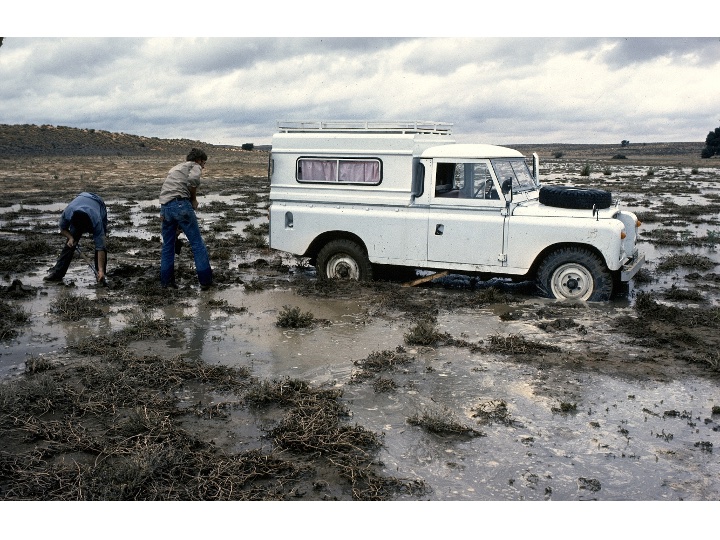
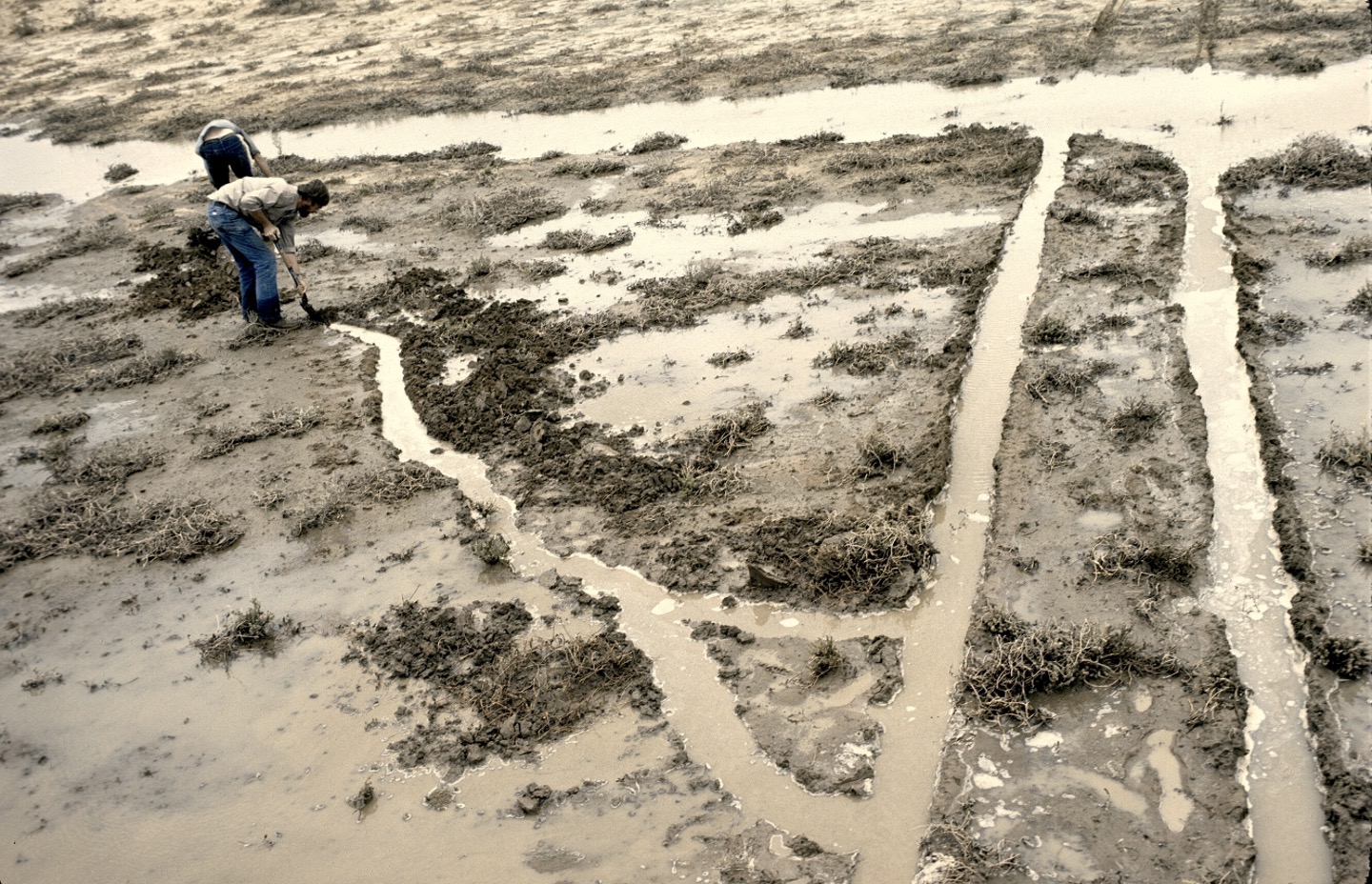
We were stuck about 100 yards south of our big *Acacia.” To our dismay, two large male lions sat under the tree.
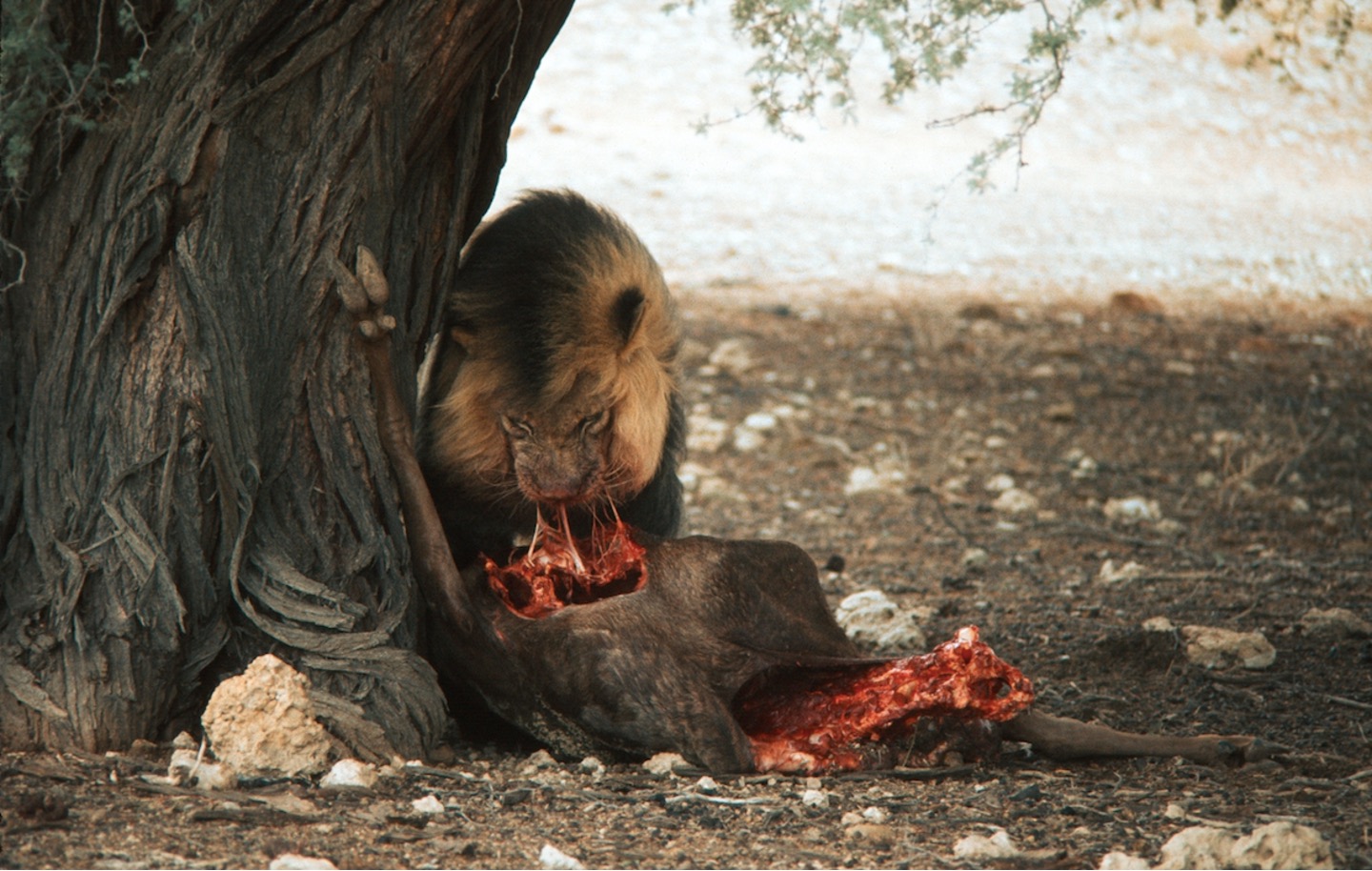
Now what? Eric knew that the only way we could get our Land Rover unstuck would be for us to get out and start digging trenches to drain the water from underneath the truck. However, we did not like the prospect of our trenching in the clear view of two large male lions, which were uncomfortably close.
We decided that the best solution would be for Eric and me to trench, and for Carolyn to stand on top of the Land Rover and watch the lions. If either lion made a move towards us, she was to shout a warning, so we try to dash back to the safety of the truck.
Trenching was slow. Eric and I were perhaps 15 yards away from the truck when Carolyn suddenly screamed. Eric and I each took our shovels into defensive positions, scanning around to see where the lions were coming from, as well as to figure out the safest route back to the Land Rover. Fortunately, the lions were still under the tree and were not an immediate threat.
Why then had Carolyn screamed? She had just seen her first ostrich screamed from excitement. Once Eric and I realized that we were safe, we both enjoyed Carolyn’s delight at seeing the ostrich.
Eventually we drained water from under the truck and were able to drive up and out of the mud. Naturally, the first thing we did was to drive over to our tree to see the lions ‘up close and personal.’ They were eating a wildebeest! Obviously, they had no interest in hunting us. Too bad we couldn’t see that when we were nervously trenching.
On subsequent visits to L, we would always drive by the big tree. It was a magnet for animals, not just for lions. Predatory birds (from pigmy falcons to pale chanting goshawks to black-breasted snake eagles) also roosted there. Once we watched a leopard trying to kill a porcupine under that tree. [Note: African porcupines are about twice the mass of American ones.] This porcupine was shaking its quills, thereby making a loud rattling sound. This porcupine’s defensive behavior was a visual and aural treat, although obviously not for the leopard.
I returned to the Kalahari in 1981. The main goal on this trip was to compare the physiological ecology of widely foraging versus sit-and-wait lacertid lizards. Eric and I’d recently published a major paper on the ecological consequences of foraging mode in these lizards, and now I wanted to determine whether physiological differences underlay the behavioral differences. Specifically, I wanted to determine whether widely foraging species had relatively high stamina and whether sit-and-wait species had relatively high acceleration and maximum sprint speed. If so, did they also differ in aerobic and anaerobic capacities? Hhow did their field metabolic rates and energy gains compare?
I teamed up with three top biologists. Al Bennett (UC Irvine) was the world’s expert on the activity and muscle physiology of lizards. Al would take primary responsibility for the physiological studies. He brought along Henry John-Alder, a talented graduate student to help.
We also wanted to compare field metabolic rates and energy gain of free-ranging lizards. The calculations that Eric and I’d made in our Ecology paper (1981) suggested that widely foraging lizards had higher net energy gains than sit-and-wait lizards. But these calculations indirect. On this new trip, we planned to use doubly-labeled water, which could better estimate a lizard’s metabolic rate and net-energy gain in nature. Ken Nagy (UCLA) would be in charge of that study – he was the world’s expert on this technique. We had a great team. [Note: see #sec-foraging for a review of our results.]
We needed a single Kalahari site where a widely foraging and a sit-and-wait species were abundant and lived in the same habitat (“syntopic”). Any observed difference in net energy gain would therefore reflect foraging mode and not a confound of habitat or site. From past trips, I knew that the dune ridge at our L area should be perfect. Two lacertids (one each of the foraging types) were both abundant and syntopic there.
But could we find L again? I feared that our tree might have drowned and been swept away when the Nossob flooded in the wet summer of 1975-1976. I knew approximately where it was, but that tree – if it survived – would help me relocate L.
So, I was anxious when we drove up the Nossob, and I as relieved and excited to see the tree, even grander and older than in the past. We drove under its sprawling branches. I introduced Al, Henry, and Ken to the tree and forced them to listen to stories about my past encounters with this tree.
We made multiple trips to L and, of course, always visited the tree, hoping to see interesting animals. But day after day, we failed to see anything special – nothing that is, until our very last day, when we drove up to the tree after a day of fieldwork and just before driving back to Twee Rivieren. Damn. Nothing! But then Al shouted, “There’s a lion!” I looked excitedly but I could not see anything. Al responded critically,
“Can’t you see it?”
I soon sensed that he was playing with me. I got out of the truck, walked toward the tree, and finally saw a lion. But it was toy lion with a bright fuchsia tail, resting peacefully on the litter under the acacia.
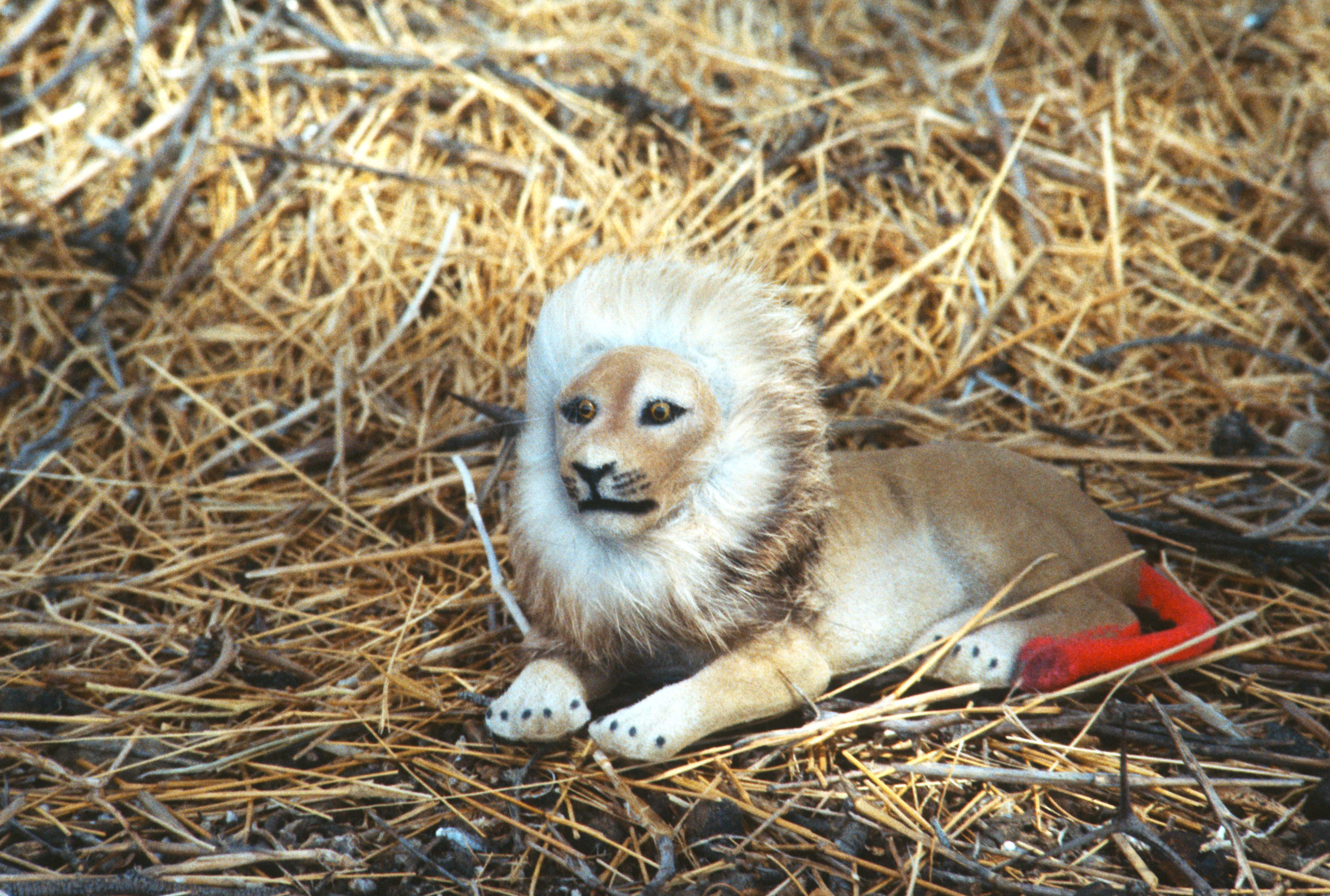 {width =60%}
{width =60%}
Al, Henry, and Ken had purchased the lion in the gift shop at the Park headquarters, and I had not noticed that one of them had sneaked over to the treen. That was gutsy, given the distance and non-zero probability of encountering a lion or leopard en route.
Why was the lion’s tail painted bright fuchsia? We used fushsia paint to mark the tails of lacertids in our doubly labeled water study – that way we would know which individual lizards to recapture.
My encounter with a doll lion was fun. Al, Ken, and Henry ‘got me good,’ and we all shared a good laugh. This was a perfect and communal end for a great set of projects with great biologists and great colleagues.
Over the subsequent decades, I often reminisced about this tree. I decided that after I died, I wanted one part of my ashes to be mixed in the tree’s leaf litter and the other part to be tucked inside a large steak and then fed to a Kalahari lion. What could be better than being recycled through a grand tree and through a lion?
I am serious about this. When I redid my Last Will and Testament, I authorized the executor of my estate to cover the round-trip expenses for a party of two to execute these wishes. If Carolyn is unable to go, I assumed one of my biology colleagues will jump at the opportunity to go back. Don Miles, who has joined me on three trips so the Kalahari, is first in line.
It was not until February 2014 – essentially a quarter of a century after the foraging-mode study – before I (still alive!) returned to the Kalahari. Barry Sinervo, Don Miles, and several colleagues had been studying the impact of global warming on lizards around the world. I knew Barry and Miles well. Barry had been a Ph.D. student and a postdoc with me. Miles spent a sabbatical year in my lab. We all liked and respected each other.
Along with several other colleagues, we submitted a grant proposal to the National Geographic Society, seeking funds to revisit some of our old Kalahari study sites and check the current status of lizards. Barry’s and Don’s theoretical models suggested that one Kalahari lacertid (Meroles) might be especially vulnerable to recent climate warming. Fortunately, National Geographic funded our research. We made three trips (2014, 2017, and 2019).
Naturally, I wanted to revisit our L site. But could I find it after several decades? I’d looked many times at Google Earth and had spotted what I thought looked like the huge dune street just southeast of our big tree. However, satellite and ground-level views often appear very different. The satellite images were disturbing because I could see many acacia trees lining the eastern bank of the Nossob River. My distinct memory from prior trips that our big acacia was a solitary tree – was I looking in the wrong area on Google Earth?
Even if I could find L, would the tree still be standing? A flood could have easily taken it out, or it might have just senesced, died, and rotted. I hoped not. I missed this tree.
So seven of us drove up the Nossob, looking for the tree. When we got to the part of the river where I thought the tree was, I saw many acacia trees along the eastern bank. I’d seen in the Google Earth image but did not remember them from previous trips. In any case, none approached the grandeur of our old patriarch – I was puzzled and slightly worried. The Nossob had changed since 1981.
But then we spotted one large tree. However, it was neither upright nor grand. Rather, our tree had fallen over at some point and now looked rather contorted and tatty, to be honest. Even so, it was definitely our tree, and it was definitely not dead! It had even sprouted two new trunks, both growing skyward. This was our tree. Tears came to Carolyn’s and my eyes. This was an emotional moment for us, and by osmosis for our colleagues seeing the tree for the first time. Somehow this tree symbolized the art and guts of survival. It was down but not out.
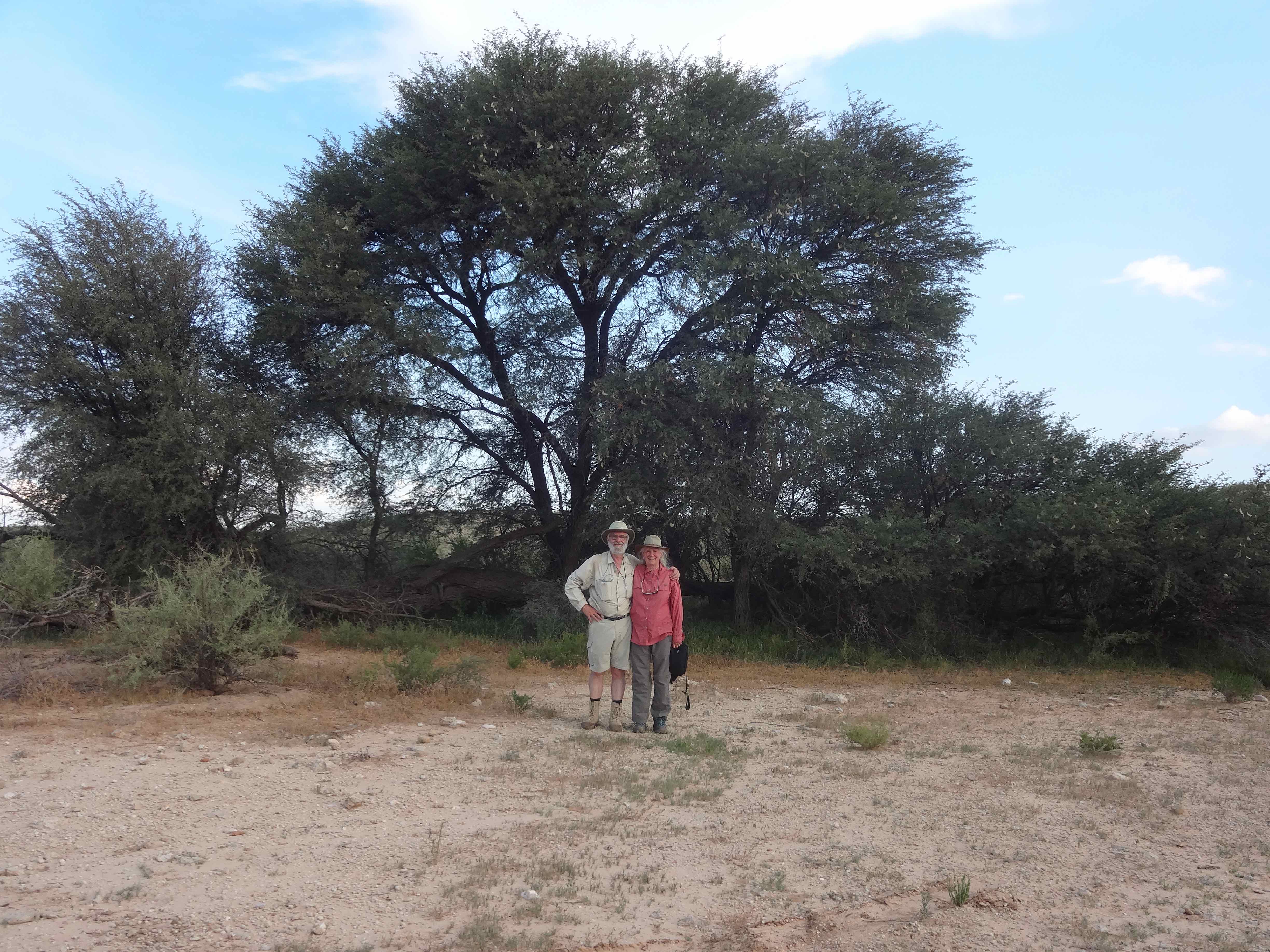
If you are lucky enough to travel to the Kalahari, drive up the Nossob. The GPS coordinates of the tree are 26.39926°S, 20.69039°E. Unfortunately, the South African track is on the west (opposite) side of the river, so you can only see the tree from a distance. However, if you have an entry permit from Botswana (recommended!), you can drive a track on the east side and visit the tree. I hope it continues to live so that its roots can absorb my ashes and recycle me into a seed pod or even better, a thorn.